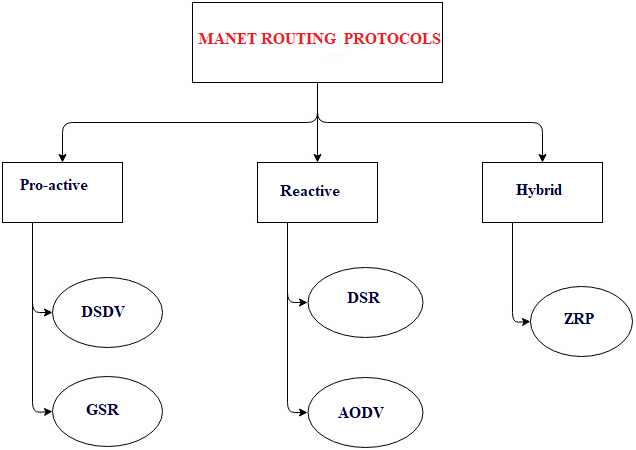MANET Routing Protocols

MANET Routing Protocols
In Mobile Ad hoc Network (MANET), nodes do not know the topology of their network, instead they have to discover it by their own as the topology in the ad-hoc network is dynamic topology. The basic rules is that a new node whenever enters into an ad-hoc network, must announce its arrival and presence and should also listen to similar announcement broadcasts made by other mobile nodes.
1. Pro-active routing protocols:
These are also known as table-driven routing protocols. Each mobile node maintains a separate routing table which contains the information of the routes to all the possible destination mobile nodes.
Since the topology in the mobile ad-hoc network is dynamic, these routing tables are updated periodically as and when the network topology changes. It has a limitation that is doesn’t work well for the large networks as the entries in the routing table becomes too large since they need to maintain the route information to all possible nodes.
DSDV
DESTINATION-SEQUENCED DISTANCE VECTOR ROUTING
Destination Sequenced Distance Vector (DSDV) Destination Sequenced Distance Vector Routing Protocol (DSDV):
It is a pro-active/table driven routing protocol. It actually extends the distance vector routing protocol of the wired networks as the name suggests. It is based on the Bellman-ford routing algorithm. Distance vector routing protocol was not suited for mobile ad-hoc networks due to count-to-infinity problem. Hence, as a solution Destination Sequenced Distance Vector Routing Protocol (DSDV) came into picture. Destination sequence number is added with every routing entry in the routing table maintained by each node. A node will include the new update in the table only if the entry consists of the new updated route to the destination with higher sequence number.
Global State Routing (GSR):
It is a pro-active/table driven routing protocol. It actually extends the link state routing of the wired networks. It is based on the Dijkstras routing algorithm. Link state routing protocol was not suited for mobile ad-hoc networks because in it, each node floods the link state routing information directly into the whole network i.e. Global flooding which may lead to the congestion of control packets in the network.
Hence, as a solution Global State Routing Routing Protocol (GSR) came into the picture. Global state routing doesn’t flood the link state routing packets globally into the network. In GSR, each of the mobile node maintains one list and three tables namely, adjacency list, topology table, next hop table and distance table.
2. Reactive routing protocols:
These are also known as on-demand routing protocol. In this type of routing, the route is discovered only when it is required/needed. The process of route discovery occurs by flooding the route request packets throughout the mobile network. It consists of two major phases namely, route discovery and route maintenance.
Dynamic Source Routing protocol (DSR):
It is a reactive/on-demand routing protocol. In this type of routing, the route is discovered only when it is required/needed. The process of route discovery occurs by flooding the route request packets throughout the mobile network.
It consists of two phases:
Route Discovery:
This phase determines the most optimal path for the transmission of data packets between the source and the destination mobile nodes.
Route Maintenance:
This phase performs the maintenance work of the route as the topology in the mobile ad-hoc network is dynamic in nature and hence, there are many cases of link breakage resulting in the network failure between the mobile nodes.
Ad-Hoc On Demand Vector Routing protocol (AODV):
It is a reactive/on-demand routing protocol. It is an extension of dynamic source routing protocol (DSR) and it helps to remove the disadvantage of dynamic source routing protocol. In DSR, after route discovery, when the source mobile node sends the data packet to the destination mobile node, it also contains the complete path in its header. Hence, as the network size increases, the length of the complete path also increases and the data packet’s header size also increases which makes the whole network slow.
Hence, Ad-Hoc On Demand Vector Routing protocol came as solution to it. The main difference lies in the way of storing the path, AODV stores the path in the routing table whereas DSR stores it in the data packet’s header itself. It also operates in two phases in the similar fashion: Route discovery and Route maintenance.
3. Hybrid Routing protocol:
It basically combines the advantages of both, reactive and pro-active routing protocols. These protocols are adaptive in nature and adapts according to the zone and position of the source and destination mobile nodes. One of the most popular hybrid routing protocol is Zone Routing Protocol (ZRP).
The whole network is divided into different zones and then the position of source and destination mobile node is observed. If the source and destination mobile nodes are present in the same zone, then proactive routing is used for the transmission of the data packets between them. And if the source and destination mobile nodes are present in different zones, then reactive routing is used for the transmission of the data packets between them.






















